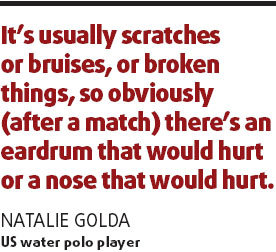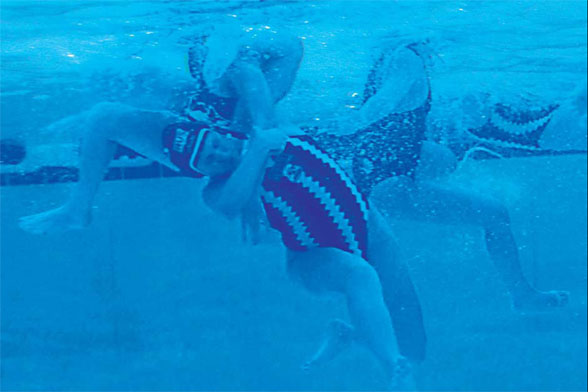A brutal battle beneath the surface
|
Women's water polo players from the Russian and Australian national teams struggle under the water during the China Water Polo Open, an Olympic test event, last week in Beijing's Ying Tung Natatorium. Yang Shizhong |
From the stands above the water's surface at Ying Tung Natatorium, the water polo venue for the Beijing Games, the sport looks a bit like basketball if it was played with teams of bobbing heads.
But take a peak below the surface through the underwater windows that line the pool's walls and you'll learn the dirty truth.
Water polo is a blend of underwater ballet moves and vicious wrestling holds. All the tossing and tangled arms and legs beneath the surface remind you more of an ultimate fighting match than a refined Olympic sport.
Take the third match of last week's 2008 China Water Polo Open at Ying Tung as an example: Jenna Santoromito of the Australian women's team had to break out of what looked like a full nelson hold from a Russian defender, violently pulling her underwater, before she could get off a shot. Scenes like this are common in any water polo match.
The fact that "drowning" and "suit grabbing" are offenses that can earn a player a penalty should give you a good idea of the types of things a water polo player endures during a typical game.
"The sport is always rough, but it's part of the game," Natalie Golda, a 27-year-old world champion on the US team, told China Daily on the sidelines of the Olympic test event.
Golda, who is considered one of the leading players in the world at the moment, told reporters four years ago in Athens that broken noses and jaws were common injuries for the sport.
"It's usually scratches or bruises, or broken things, so obviously (after a match) there's an eardrum that would hurt or a nose that would hurt," she said.
Calling more fouls
But Golda says the referees are calling more fouls than in the past in an effort to clean up the dirty play underwater.
"Yes, we whistle faster. We whistle the fouls that stop attacks in the first physical contact," said Ahmet Erhan Tulga, a renowned referee with 11 years of experience. "We are not leaving as much room for such a brutal game as before."
In last week's match between Australia and Russia, which the Aussies won 13-8, there was a foul called in nearly every attack attempt. But the quick calls from the two referees kept the game going smoothly and players restarted without much delay.
Coaches also say traditional grabbing is losing out to clever tactics and good positioning built on hundreds of hours practicing basic skills.
"There's no place for (violence). Hopefully, we are playing tactically sound, position-wise defense," said Guy Baker, who has coached the US women's team for 10 years. "I think those things are more important."
Still, with opponents clutching and clawing and trying to restrict even the most basic moves, players have to train hard just to stay above water. They must constantly tread water in "eggbeater" style while deflecting the reach of opponents as they handle the ball.
Rigorous training

To train for the underwater punishment, players spend hours in the pool treading water with weights. Teng Fei, a defender and captain for China's women's team, said her players wear sandbags around their waists while treading water. Coach Baker said his girls throw heavy medicine balls during their training.
"Water polo to me is the greatest sport," Baker said. "You have to be skilled. You have to have strength. You have to have some speed. As you are doing all these things, you have to handle the ball."
"It is a very, very tough sport," said Rebecca Rippon, a veteran on the Australian team. "I think a lot of people don't appreciate how tough it is until they see it."
Although water polo powerhouses in Europe, the US and Australia may continue their dominance in Beijing this summer, the Chinese players, especially the girls, fancy their chances as the home team.
"They have been doing a lot of work on their strength, and tactically they are much better. They've improved a lot and they are very competitive now," said Rippon, who played against the Chinese women during the World Championships in 2005.
"Physical conditions are not a disadvantage for the Chinese girls. The biggest problem is they are too young," said Juan Jane Giralt, coach of Olympic champion Spain in the Barcelona Games and now Team China. "I really want to train Chinese girls to think before they make the moves."
(China Daily 03/27/2008 page22)















